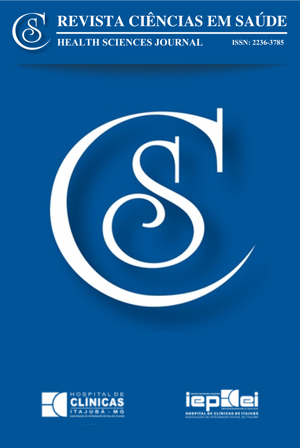Interference of sedentary behavior and physical activity in the burnout indicators of physical education students
Main Article Content
Abstract
Objective: to verify if sedentary behavior and the duration and frequency of physical activity interfere in the burnout indicators of physical education university students. Methods: a cross-sectional study, carried out with 147 physical education students, bachelor's degrees, of both genres. An adaptation for the academic context (students) of the Cuestionario para la Evaluación del Síndrome de Quemarse por el Trabajo was used, and the International Physical Activity Questionnaire (IPAQ - short version). Data were analyzed by the Kolmogorov-Smirnov and “U” tests by Mann-Whitney, and the level of significance was set at p <0.05. Results: students who walk up to 40 min a day showed more significant burnout symptoms than students with longer walking time in the day (p = 0.007). Students who walk up to 135 min a week showed higher indications for the development of psychological wear than those who walk more than 135 min a week (p = 0.017). Students who practice up to 60 min of moderate activities per day had a higher score than students who practice more than 60 min of moderate activities per day (p = 0.011). Significant differences were found in indolence (p = 0.011) and guilt (p = 0.023) dimensions, showing that students who spend more time sitting had a higher score in both dimensions of burnout. Conclusion: the duration and frequency of physical activity and sedentary behavior interfere with the indications of burnout in physical education students.
Article Details
Authors maintain copyright and grant the HSJ the right to first publication. From 2024, the publications wiil be licensed under Attribution 4.0 International 
 , allowing their sharing, recognizing the authorship and initial publication in this journal.
, allowing their sharing, recognizing the authorship and initial publication in this journal.
Authors are authorized to assume additional contracts separately for the non-exclusive distribution of the version of the work published in this journal (e.g., publishing in an institutional repository or as a book chapter), with acknowledgment of authorship and initial publication in this journal.
Authors are encouraged to publish and distribute their work online (e.g., in institutional repositories or on their personal page) at any point after the editorial process.
Also, the AUTHOR is informed and consents that the HSJ can incorporate his article into existing or future scientific databases and indexers, under the conditions defined by the latter at all times, which will involve, at least, the possibility that the holders of these databases can perform the following actions on the article.
References
Wainwright E, Looseley A, Mouton R, O'connor M, Taylor G, Cook TM. Stress, burnout, depression and work satisfaction among UK anaesthetic trainees: a qualitative analysis of in-depth participant interviews in the Satisfaction and Wellbeing in Anaesthetic Training study. Anaesthesia. 2019;74:1240-51. https://doi.org/10.1111/anae.14694 PMid:31090927
Murofuse NT, Abranches SS, Napoleão AA. Reflexões sobre estresse e Burnout e a relação com a enfermagem. Rev Latino-Am Enferm. 2005;13(2):255-61. https://doi.org/10.1590/S0104-11692005000200019 PMid:15962073
Wang Y, Ramos A, Wu H, Liu L, Yang X, Wang J, Wang L. Relationship between occupational stress and burnout among Chinese teachers: a cross-sectional survey in Liaoning, China. Int Arch Occup Environ Health. 2015;88:589-97. https://doi.org/10.1007/s00420-014-0987-9 PMid:25256806
Mota ID, Marinho APR, Both J, Veiga MB, Farias GO. Relação entre atividade física e Síndrome de Burnout em estudantes universitários: revisão sistemática. Pensar Prática. 2019;22:1-15. https://doi.org/10.5216/rpp.v22.52184
Santos EG, Siqueira MM. Prevalência dos transtornos mentais na população adulta brasileira: uma revisão sistemática de 1997 a 2009. J Bras Psiquiatr. 2010;59(3):238-46. https://doi.org/10.1590/S0047-20852010000300011
Unger JP. Physicians' Burnout (and That of Psychologists, Nurses, Magistrates, Researchers, and Professors) for a control program. Int J Health Serv. 2020;50(1):73-81. https://doi.org/10.1177/0020731419883525 PMid:31672078 PMCid:PMC7134576
Maslach C, Leiter MP. Understanding the burnout experience: recent research and its implications for psychiatry. World Psychiatry. 2016;15(2):103-11. https://doi.org/10.1002/wps.20311 PMid:27265691 PMCid:PMC4911781
Wilkes C, Lewis T, Brager N, Bulloch UM, Macmaster F, Paget H, et al. Wellbeing and mental health amongst medical students in Canada. Int Rev Psychiatry. 2019;31(2):1-4. https://doi.org/10.1080/09540261.2019.1675927 PMid:31638441
Mota ID, Farias GO, Silva R, Folle, A. I. Síndrome de burnout em estudantes universitários: um olhar sobre as investigações. Motrivivência. 2017;29:243-56. https://doi.org/10.5007/2175-8042.2017v29nespp243
Goebel DK, Carlotto MS. Predictores sociodemográficos, laborales y psicosociales del Síndrome de Burnout en docentes de educación a distancia. Avances Psicol Latinoam. 2019; 37(2):295-311. https://doi.org/10.12804/revistas.urosario.edu.co/apl/a.6886
Manosso M, Lanferdini FJ, Dal'Agnol MJ, Roncada C, Dias CP. Comparação dos níveis de estresse e estilo de vida entre praticantes e não praticantes de ginástica laboral. Rev Bras Ciência Mov. 2014;22(2):65-71. https://doi.org/10.18511/0103-1716/rbcm.v22n2p65-71
World Health Organization (WHO). Global Recommendations on Physical Activity for Health 18-64 years old. WHO:Geneve;2010 [cited 31 Oct 2020]. Avaiable from: https://www.who.int/dietphysicalactivity/global-PA-recs-2010.pdf
Serinolli MI, El-Mafarjeh E. Impacto da prática de atividade física na qualidade de vida dos acadêmicos de Medicina da Universidade Nove de Julho (Uninove). ConScientiae Saúde. 2015;14(4):627-33. https://doi.org/10.5585/conssaude.v14n4.5958
Gil-Monte PR, Carlotto MS, Câmara SG. Validação da versão brasileira do "Cuestionario para la Evaluación del Síndrome de Quemarse por el Trabajo" em professores. Rev Saúde Pública. 2010;44(1):140-7. https://doi.org/10.1590/S0034-89102010000100015
Matsudo S, Araújo T, Matsudo V, Andrade D, Andrade E, Oliveira LC, et al. Questionário Internacional de Atividade Física (Ipaq): Estudo de validade e reprodutibilidade no Brasil. Rev Bras Ativ Fís Saúde. 2001;6(2):5-18.
Cecil J, Calum MH, Hart J, Laidlaw A. Behaviour and burnout in medical students. Medic Educ Online. 2014;19. https://doi.org/10.3402/meo.v19.25209 PMid:25160716 PMCid:PMC4145104
Fares J, Saadeddin Z, Tabosh H, Aridi H, Mouhayyar C, Koleilat MK, et al. Extracurricular activities associated with stress and burnout in preclinical medical students. J Epidemiol Glob Health. 2015;6(3):177-85. https://doi.org/10.1016/j.jegh.2015.10.003 PMid:26644345 PMCid:PMC7320478
Carlotto MS, Nakamura AP, Câmara SG. Síndrome de Burnout em estudantes universitários da área da saúde. Psico. 2006 [cited 31 Oct 2020];37(1):57-62. Avaiable from: https://revistaseletronicas.pucrs.br/ojs/index.php/revistapsico/article/view/1412
